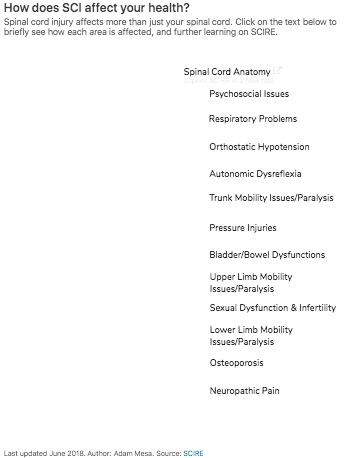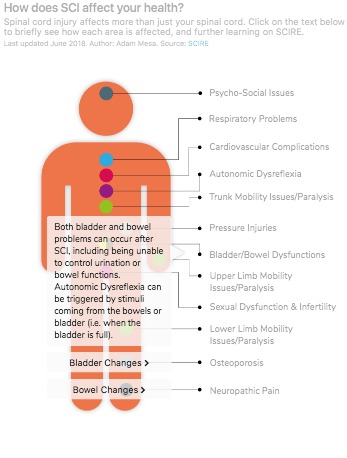
How does SCI affect your health?
Spinal cord injury affects more than just your spinal cord. Click on the text below to briefly see how each area is affected, and further learning on SCIRE.
Published June 2018. Last updated July 2019. Author: Adam Mesa. Source: SCIRE
Psychosocial Issues
Respiratory Problems
Orthostatic Hypotension
Autonomic Dysreflexia
Trunk Mobility Issues/Paralysis
Pressure Injuries
Bladder/Bowel Dysfunctions
Upper Limb Mobility
Issues/Paralysis
Sexual Dysfunction & Infertility
Lower Limb Mobility
Issues/Paralysis
Osteoporosis
Neuropathic Pain
Spinal Cord Anatomy
Spinal Cord Anatomy
(Opens SCIRE in a new tab)
On a smartphone? View this page in landscape mode or on your laptop!

Life satisfaction and subjective well-being have been found to be lower in people with SCI, irrespective of level of injury.
Learn more
The muscles involved in carrying out respiration can be affected by spinal cord injury. The most important muscle of respiration, the diaphragm, is innervated between spinal cord levels C3 and C5. Injury at or above this point may result in the need for mechanical assistance to breathe.
Learn more
After high-level SCI, people commonly experience orthostatic (postural) hypotension. Orthostatic hypotension, or low blood pressure, can be caused by changing position between lying down and sitting or standing in an upright position. Normally, after moving to an upright position, blood vessels in the legs constrict to prevent gravity from pulling blood away from the heart and brain. This may be delayed following an SCI.
Learn more Read the comic
Changes in sensation and/or motor function occur below the level of SCI. The degree of change varies depending on the extent of injury. Neurons branching out below the level of SCI may be injured and no longer capable of receiving signals or transmitting them from the brain to the areas of the body they normally connect with.
Learn more
Pressure injuries, also known as bedsores, are a common complication after SCI. Pressure injuries are caused by the combination of pressure and shear forces on the skin and tissue below it. Pressure can prevent blood from reaching the area affected, and the skin can become less elastic due to tissue changes after SCI.
Learn more
Both bladder and bowel problems can occur after SCI, including being unable to control urination or bowel functions. Autonomic dysreflexia (see above) can be triggered by stimuli coming from the bowels or bladder (e.g. when the bladder is full).
Bladder Changes Bowel Changes
Changes to sexual desire, sensation, arousal, and orgasm may be caused directly by the injury. Furthermore, other changes like self-image and life roles may affect sexual health after SCI.
Learn more
Osteoporosis is the weakening of bone due to density loss, making the bones more likely to break following simple activities. SCI may result in decreased density in hip and knee region bone density.
Learn more
Pain from the nerves is called neuropathic pain, and can originate anywhere form the body including below the level of SCI. It may occur randomly or may be felt in areas far away from where the damaged nerve is.
Learn more Read the comic
Autonomic dysreflexia (AD), or episodes of dangerously high blood pressure, can be caused by various stimuli below the level of injury. AD is considered a medical emergency and can affect people with SCI at T6 and above.
Learn moreDo you know all the ways that SCI affects your body? Take a look at our interactive map to find out!


